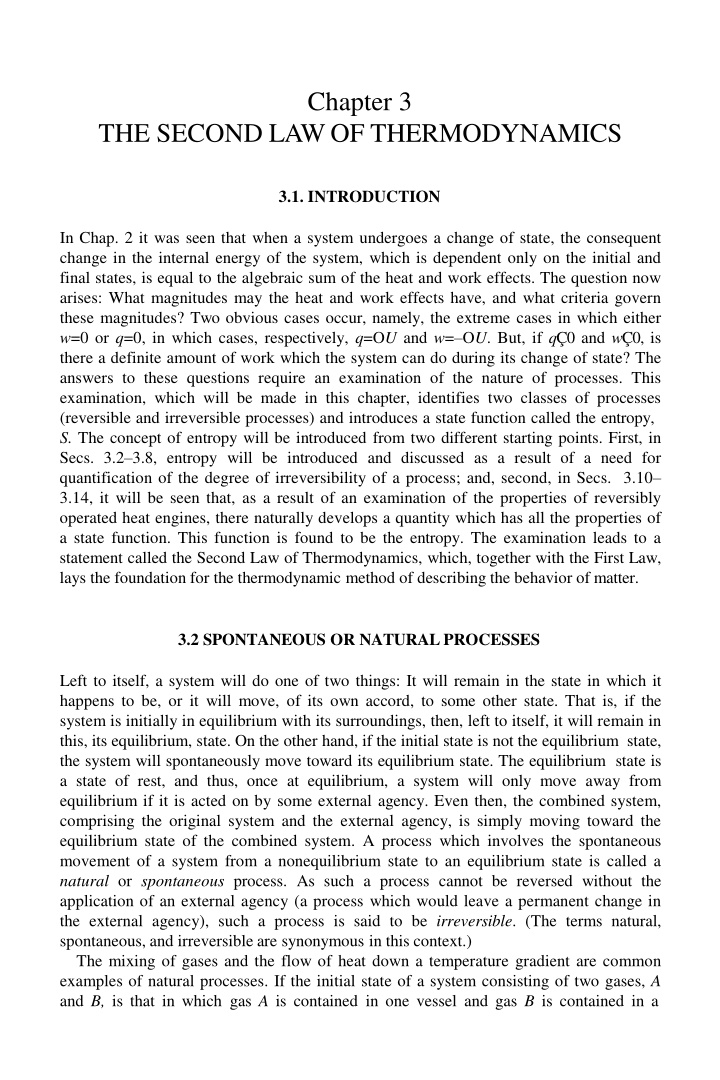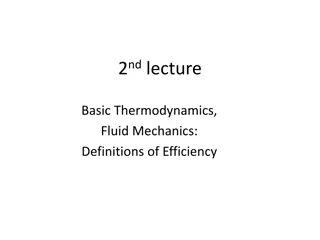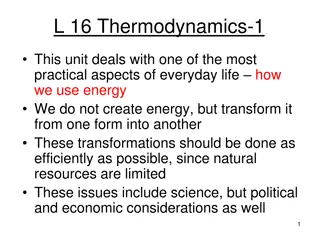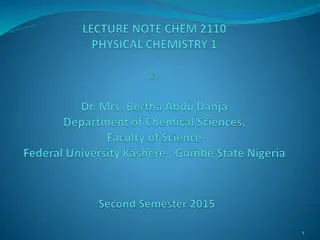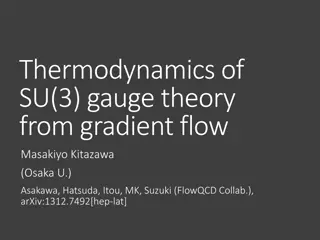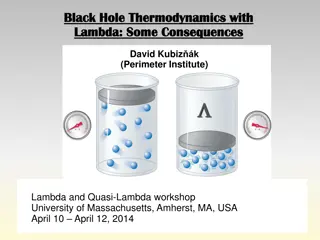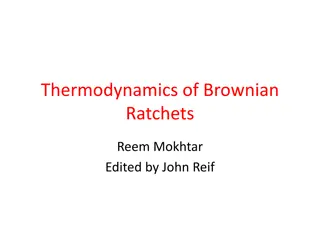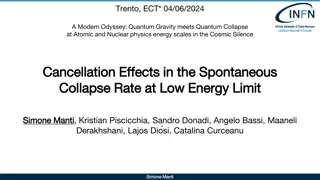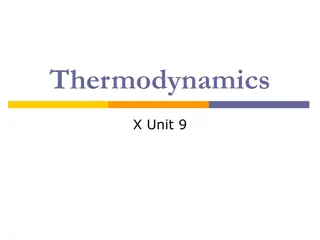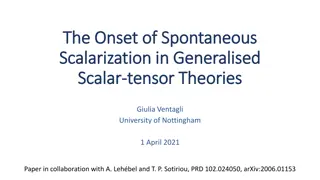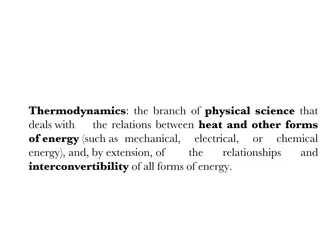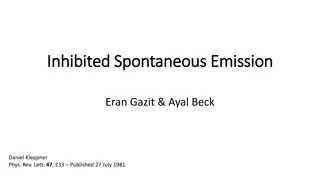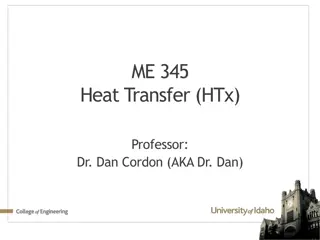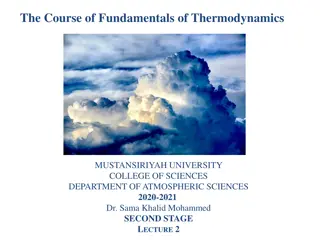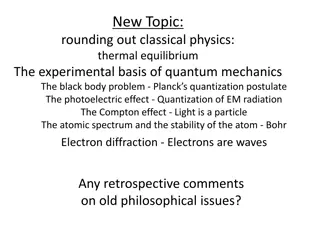The Second Law of Thermodynamics and Spontaneous Processes
This chapter delves into the Second Law of Thermodynamics, introducing the concept of entropy and discussing spontaneous processes. It explores the movement of systems towards equilibrium states and the irreversibility of natural processes.
Download Presentation

Please find below an Image/Link to download the presentation.
The content on the website is provided AS IS for your information and personal use only. It may not be sold, licensed, or shared on other websites without obtaining consent from the author.If you encounter any issues during the download, it is possible that the publisher has removed the file from their server.
You are allowed to download the files provided on this website for personal or commercial use, subject to the condition that they are used lawfully. All files are the property of their respective owners.
The content on the website is provided AS IS for your information and personal use only. It may not be sold, licensed, or shared on other websites without obtaining consent from the author.
E N D
Presentation Transcript
Chapter 3 THE SECOND LAW OF THERMODYNAMICS 3.1. INTRODUCTION In Chap. 2 it was seen that when a system undergoes a change of state, the consequent change in the internal energy of the system, which is dependent only on the initial and final states, is equal to the algebraic sum of the heat and work effects. The question now arises: What magnitudes may the heat and work effects have, and what criteria govern these magnitudes? Two obvious cases occur, namely, the extreme cases in which either w=0 or q=0, in which cases, respectively, q=OU and w= OU. But, if q 0 and w 0, is there a definite amount of work which the system can do during its change of state? The answers to these questions require an examination of the nature of processes. This examination, which will be made in this chapter, identifies two classes of processes (reversible and irreversible processes) and introduces a state function called the entropy, S. The concept of entropy will be introduced from two different starting points. First, in Secs. 3.2 3.8, entropy will be introduced and discussed as a result of a need for quantification of the degree of irreversibility of a process; and, second, in Secs. 3.10 3.14, it will be seen that, as a result of an examination of the properties of reversibly operated heat engines, there naturally develops a quantity which has all the properties of a state function. This function is found to be the entropy. The examination leads to a statement called the Second Law of Thermodynamics, which, together with the First Law, lays the foundation for the thermodynamic method of describing the behavior of matter. 3.2 SPONTANEOUS OR NATURALPROCESSES Left to itself, a system will do one of two things: It will remain in the state in which it happens to be, or it will move, of its own accord, to some other state. That is, if the system is initially in equilibrium with its surroundings, then, left to itself, it will remain in this, its equilibrium, state. On the other hand, if the initial state is not the equilibrium state, the system will spontaneously move toward its equilibrium state. The equilibrium state is a state of rest, and thus, once at equilibrium, a system will only move away from equilibrium if it is acted on by some external agency. Even then, the combined system, comprising the original system and the external agency, is simply moving toward the equilibrium state of the combined system. A process which involves the spontaneous movement of a system from a nonequilibrium state to an equilibrium state is called a natural or spontaneous process. As such a process cannot be reversed without the application of an external agency (a process which would leave a permanent change in the external agency), such a process is said to be irreversible. (The terms natural, spontaneous, and irreversible are synonymous in this context.) The mixing of gases and the flow of heat down a temperature gradient are common examples of natural processes. If the initial state of a system consisting of two gases, A and B, is that in which gas A is contained in one vessel and gas B is contained in a
The Second Law of Thermodynamics 43 separate vessel, then, when the vessels are connected to one another, the system spontaneously moves to the equilibrium state in which the two gases are completely mixed, i.e., the composition of the gas mixture is uniform throughout the volume which the gas occupies. If the initial state of a two-body system is that in which one body is at one temperature and the other body is at another temperature, then, when the bodies are placed in thermal contact with one another, the spontaneous process which occurs is the flow of heat from the hotter to the colder body, and the equilibrium state is reached when both bodies attain a common uniform temperature. In both of these examples the reverse process (unmixing of the gases and the flow of heat up a temperature gradient) will never occur spontaneously, and in both examples the simplicity of the system, along with common experience, allows the equilibrium states to be predicted without any knowledge of the criteria for equilibrium. However, in less simple systems, the equilibrium state cannot be predicted from common experience, and the criteria governing equilibrium must be established before calculation of the equilibrium state can be made. Determination of the equilibrium state is of prime importance in thermodynamics, as knowledge of this state for any materials reaction system will allow determination to be made of the direction in which any reaction will proceed from any starting or initial state. For example, knowledge of the equilibrium state of a chemical reaction system such as will afford knowledge of whether, from any initial state which would be some mixture of A, B, C, and D the reaction will proceed from right to left or from left to right, and, in either case, to what extent before equilibrium is reached. If a system undergoes a spontaneous process involving the performance of work and the production of heat, then, as the process continues, during which time the system is being brought nearer and nearer to its equilibrium state, the capacity of the system for further spontaneous change decreases. Finally, once equilibrium is reached, the capacity of the system for doing further work is exhausted. In the initial nonequilibrium state of an isolated system (a system of constant internal energy), some of the energy of the system is available for doing useful work, and when the equilibrium state is reached, as a result of the completion of a spontaneous process, none of the energy of the system is available for doing useful work. Thus, as a result of the spontaneous process, the system has become degraded, in that energy, which was available for doing useful work, has been converted to thermal energy (or heat), in which form it is not available for external purposes. 3.3 ENTROPY AND THE QUANTIFICATION OFIRREVERSIBILITY Two distinct types of spontaneous process are (1) the conversion of work to heat (i.e., the degradation of mechanical energy to thermal energy) and (2) the flow of heat down a temperature gradient. If it is considered that an irreversible process is one in which the energy of the system undergoing the process is degraded, then the possibility that the extent of degradation can differ from one process to another suggests that a quantitative measure of the extent of degradation, or degree of irreversibility, exists. The existence of
44 Introduction to the Thermodynamics of Materials processes which exhibit differing degrees of irreversibility can be illustrated as follows. Consider the weight-heat reservoir system shown schematically in Fig. 3.1. This system consists of a weight-pulley arrangement which is coupled to a constanttemperature heat reservoir, and the system is at equilibrium when an upward force acting on the weight exactly balances the downward force, W, of the weight. If the upward force is removed, then the equilibrium is upset and the weight spontaneously falls, thus performing work, which is converted, by means of a suitable system of paddle wheels, to heat which enters the constant-temperature heat reservoir. Equilibrium is reattained when the upward force acting on the weight is replaced, and the net effect of this process is that mechanical energy has been converted to thermal energy. Lewis and Randall* considered the following three processes: 1. The heat reservoir in the weight-heat reservoir system is at the temperature T2. The weight is allowed to fall, performing work, w, and the heat produced, q, enters the heat reservoir. 2. The heat reservoir at the temperature T2is placed in thermal contact with a heat reservoir at a lower temperature T1, and the same heat q is allowed to flow from the reservoir at T2 to the reservoir atT1. 3. The heat reservoir in the weight-heat reservoir system is at the temperature T1. The weight is allowed to fall, performing work, w, and the heat produced, q enters the reservoir. Figure 3.1 A weightpulley-heat reservoir arrangement in which the work done by the falling weight is degraded to heat, which appears in the heat reservoir *G.N.Lewis and M.Randall, Thermodynamics, revised by K.S.Pitzer and L.Brewer, 3rd ed., p. 78, McGraw-Hill, New York, 1995.
45 The Second Law of Thermodynamics Each of these process is spontaneous and hence irreversible, and degradation occurs in each of them. However, as process (3) is the sum of processes (1) and (2), the degradation occurring in process (3) must be greater than the degradation occurring in each of the processes (1) and (2). Thus it can be said that process (3) is more irreversible than either process (1) or process (2). Examination of the three processes indicates that both the amount of heat produced, q, and the temperatures between which this heat flows are important in defining a quantitative scale of irreversibility. In the case of comparison between process (1) and process (3), the quantity q/T2is smaller than the quantity q/T1, with is in agreement with the conclusion that process (1) is less irreversible than process (3). The quantity q/T is thus taken as being a measure of the degree of irreversibility of the process, and the value of q/T is called the increase in entropy, S, occurring as a result of the process. Thus when the weight-heat reservoir system undergoes a spontaneous process which causes the absorption of heat q at the constant temperature T, the entropy produced by the system, OS, is given by (3.1) The increase in entropy, caused by the process, is thus a measure of the degree of irreversibility of the process. 3.4 REVERSIBLE PROCESSES As the degree of irreversibility of a process is variable, it should be possible for the process to be conducted in such a manner that the degree of irreversibility is minimized. The ultimate of this minimization is a process in which the degree of irreversibility is zero and in which no degradation occurs. This limit, toward which the behavior of real systems can be made to approach, is the reversible process. If a process is reversible, then the concept of spontaneity is no longer applicable. It will be recalled that spontaneity occurred as a result of the system moving, of its own accord, from a nonequilibrium state to an equilibrium state. Thus, if the spontaneity is removed, it is apparent that at all times during the process, the system is at equilibrium. Thus a reversible process is one during which the system is never away from equilibrium, and a reversible process which takes the system from the state A to the state B is one in which the process path passes through a continuum of equilibrium states. Such a path is, of course, imaginary, but it is possible to conduct an actual process in such a manner that it is virtually reversible. Such an actual process is one which proceeds under the influence of an infinitesimally small driving force such that, during the process, the system is never more than an infinitesimal distance from equilibrium. If, at any point along the path, the minute external influence is removed, then the process ceases, or, if the direction of the minute external influence is reversed, then the direction of the process is reversed. Natural and reversible processes are illustrated in the following discussion.
46 Introduction to the Thermodynamics of Materials 3.5 AN ILLUSTRATION OF IRREVERSIBLE AND REVERSIBLE PROCESSES Consider a system of water and water vapor at the uniform temperature T contained in a cylinder fitted with a frictionless piston, and let the cylinder be placed in thermal contact with a heat reservoir which is also at the constant temperature T.This system is shown in Fig. 3.2 Figure 3.2 A thermostalled piston and cylinder containing water and water vapor. , which is the The water vapor in the cylinder exerts a certain pressure saturated vapor pressure of water at the temperature T. The system is exactly at equilibrium when the external pressure acting on the piston, Pext, equals the internal pressure acting on the piston, , and when the temperature of the water+water vapor in the cylinder equals the temperature T of the constant-temperature heat reservoir. If the external pressure acting on the piston, Pextis suddenly decreased by a finiteamount OP, then the imbalance in pressure causes the piston to accelerate rapidly out of the cylinder. The consequent rapid expansion of the water vapor decreases the water vapor pressure to a value below its saturation (and hence equilibrium) value, and thus water spontaneously evaporates in an attempt to reestablish equilibrium between the water and its vapor. The spontaneous evaporation, being endothermic, decreases the temperature of the water, and hence sets up a temperature gradient between the heat reservoir and the
The Second Law of Thermodynamics 47 contents of the cylinder. This, in turn, causes heat to flow spontaneously from the heat reservoir to the cylinder in an attempt to reestablish thermal equilibrium between the two. If, when 1 mole of water has evaporated, the external pressure acting on the piston is instantaneously increased to the original value, Pext, then evaporation of the water vapor ceases, the flow of heat ceases, and compete equilibrium is reestablished. The work done by the system during this process equals (Pext OP)V, where V is the molar volume of water vapor at . If the external pressure acting on the piston is suddenly increased by a finite amount OP, then the piston accelerates rapidly into the piston. The compression of the water vapor increases its pressure to a value greater than the saturation value, and hence spontaneous condensation occurs, which, being exothermic, increases the temperature in the cylinder to a value higher than T. The temperature gradient between the cylinder and the heat reservoir then causes the spontaneous flow of heat from the cylinder to the reservoir. If, when 1 mole of water vapor has been condensed, the external pressure acting on the piston is instantaneously decreased to its original value, equilibrium is reestablished and the work done on the system equals (Pext+OP)V.The permanent change in the external agency caused by the cyclic process is thus 2OPV. Consider, again, the evaporation process. If the magnitude of Pextis decreased by an infinitesimal amount 6P, the resulting minute imbalance between the pressures acting on the piston causes the cylinder to move slowly out of the piston. The slow expansion of the water vapor decreases its pressure, and when the pressure has fallen by an infinitesimal amount below the saturation value, evaporation of the water begins. The evaporation sets up an infinitesimal temperature gradient between the heat reservoir and the cylinder, down which flows the required latent heat of evaporation of the water. The smaller the value of 6P, then the slower the process, the smaller the degree of undersaturation of the water vapor, and the smaller the temperature gradient. The more slowly the process is carried out, then the greater the opportunity afforded to the evaporation and heat flow process to keep up with equilibrium. If, after the evaporation of 1 mole of water, the external pressure is instantaneously increased to its original value Pext, then the work done by the system equals (Pext 6P)V. If the external pressure is then increased by 6P, then work (Pext+6P)V, is done on the system to condense 1 mole of water vapor, and the permanent change in the external agency equals the work done on the system minus the work done by the system during the cyclic process. It is thus seen that the smaller the value of 6P, then the more nearly equal are the two work terms, and in the limit that they are equal, no permanent change occurs in the external agency, and hence the cyclic process has been conducted reversibly. It is thus seen that reversibility is approached when the evaporation or condensation processes are carried out in such a manner that the pressure exerted by the water vapor is never more than infinitesimally different from its saturation value at the temperature T. It can also be seen that, a complete reversibility is approached, the process becomes infinitely slow.
48 Introduction to the Thermodynamics of Materials 3.6 ENTROPY AND REVERSIBLEHEAT Consider only the evaporation process. The work done by the system during the evaporation of 1 mole is seen to have its maximum value, wmax=PextV, the process is conducted reversibly. Any irreversible evaporation process performs less w=(Pext OP)V. The change in the value of U for the system caused by the evaporation of 1 mole of water is independent of whether the process is conducted reversibly or not, and thus, from the First Law, Eq. (2.1), it is seen that the maximum amount of heat, qrev, is transferred from the heat reservoir to the cylinder when the process is carried out reversibly, where qrev=OU+wmax. If the process is carried out irreversibly, then less heat q is transferred from the reservoir to the cylinder, where q=OU+w. The difference between the work done during the reversible process and that done during the irreversible process, (wmax w), is the mechanical energy which has been degraded to thermal energy (heat) in the cylinder as a result of the irreversible nature of the process. This heat produced by degradation, which is given as (qrev q)=(wmax w), accounts for the fact that less heat is transferred to the cylinder from the reservoir during the irreversible process than is transferred during the reversible process. Thus, if the evaporation process is conducted reversibly, then heat qrevleaves the heat reservoir and enters the cylinder at the temperature T. The change in the entropy of the heat reservoir is given by Eq. (3.1) as work, where the negative sign corresponds to heat leaving the heat reservoir, and thus the entropy of the reservoir decreases. The change in the entropy of the water and water vapor in the cylinder is where the positive sign corresponds to heat entering the cylinder, and thus the entropy of he contents of the cylinder increases. The change in the entropy of the combined water- vapor-heat reservoir system is thus This zero change in entropy is due to the fact that the process was carried out reversibly, i.e., no degradation occurred during the process. If the evaporation is carried out irreversibly then heat q (q<qrev) is transferred from the reservoir to the cylinder. The change in the entropy of the heat reservoir is thus
The Second Law of Thermodynamics 49 However, the total heat appearing in the cylinder equals the heat q transferred from the heat reservoir plus the heat which is produced by degradation of work due to the irreversible nature of the process. Thus degraded work, (wmax w), equals (qrev q), and thus the change in the entropy of the contents of the cylinder is which, it is seen, is simply qrev/T. Thus the change in the entropy of the combined system caused by the irreversible nature of the process is As qrev>q, this entropy change is positive, and thus entropy has been produced (or created) as a result of the occurrence of an irreversible process. The entropy produced, (qrev q)/T, is termed OSirreversible(OSirr) and is the measure of the degradation which has occurred as a result of the process. Thus, for the evaporation process, irrespective of the degree of irreversibility, (3.2) Consideration of the condensation process shows that the work done on the system has a minimum value when the condensation is conducted reversibly, and, correspondingly, the heat transferred from the cylinder to the heat reservoir has a minimum value qrev. If the process is conducted irreversibly then a greater amount of work must be performed, and the excess of this work over the minimum required is the work which is degraded to heat in the irreversible process. This extra heat, in turn, is the difference between that leaving the cylinder, q, and the minimum heat qrev.
50 Introduction to the Thermodynamics ofMaterials Thus, for a reversible condensation and i.e., entropy is not created. For an irreversiblecondensation, and And, as q>qrev, it is seen that entropy has been created as a result of the irreversible process. The entropy created is OSirr, and, thus, again, the change in the entropy of the water and water vapor is given by (3.3) The important feature to be noted from Eqs. (3.2) and (3.3) is that, in going from an initial state to a final state [either the evaporation or condensation of 1 mole of water at , and the temperature T], the left-hand sides of Eqs. (3.2) and the pressure (3.3) are constants, being equal, respectively, to qrev/T and qrev/T. The difference in entropy between the final and initial states is thus independent of whether the process is conducted reversibly or irreversibly and, being independent of the process path, can be considered as being the difference between the values of a state function. This state function is the entropy, and in going from state A to state B
The Second Law of Thermodynamics 51 (3.4a) (3.4b) Eq (3.4b) indicates that, as the change in entropy can be determined only by measure- ment of heat flow at the temperature T, then entropy changes can be measured only for reversible processes, in which case the measured heat flow is q rev and OS irr =0. 3.7 THE REVERSIBLE ISOTHERMAL COMPRESSION OF ANIDEAL GAS Consider the reversible isothermal compression of 1 mole of an ideal gas from the state (VA, T) to the state (VB, T). The gas is placed in thermal contact with a heat reservoir at the temperature T, and, by application of a falling weight, the gas is compressed slowly enough that, at all times during its compression, the pressure exerted on the gas is only infinitesimal- ly greater than the instantaneous pressure of the gas, Pinst, where Pinst=RT/Vinst. The state of the gas thus lies, at all times, on a section at the constant temperature T of the P-V-T surface (Figs 1.1 and 1.3a), and hence the gas passes through a continuum of equilibrium states in going from the state (VA, T) to the state (VB, T). As the gas is never out of equilibrium, i.e., the process is reversible, no degradation occurs, and thus entropy is not cre- ated. Entropy is simply transferred from the gas to the heat reservoir, where it is measured as the heat entering divided by the temperature T.* As the compression is conducted is othermally, OU=0 and thus the work done on the gas=the heat withdrawn from thegas, i.e., *Thepertinentfeatureofa constant-temperatureheatreservoiristhatitexperiencesonlyheateffectsand neitherperformsworknorhasworkperformedonit.The icecalorimeter, whichcomprisesasystemofice andwaterat0 Cand1 atmpressure,isan exampleofa simpleconstant-temperatureheatreservoir.Heat flowing into or out of this calorimeter at 0 C is measured as the change occurring in the ratio of ice to water present as a result of the heat flow, and as the molar volume of ice is larger than that of water, the change in this ratio is measured as a change in the total volume of ice+water in the calorimeter. Strictly speaking, if heat flows out of the calorimeter, thus freezing some of the water, the volume of the system increases, and hence the calorimeter does, in fact, perform work of expansion against the atmospheric pressure. However, the ratio of the work done in expan- sion to the corresponding heat leaving the system is small enough that the work effects may be neglected, as is illustrated below. At 0 C and 1 atm, the molar volume of ice is 19.8 cm3, and the molar volume of water is 18 cm3. Thus, the work done against the atmosphere during the freezing of 1 mole of water at 0 C is 1 1.8 10 3 101.3=0.182 J. The latent heat of freezing of 1 mole of water is 6 kJ. On the other hand, the falling weight which performs the work of compression does not experience heat effects, and. as change in entropy is caused by the flow of heat, changes of entropy do not occur then in the falling weight.
52 Introduction to the Thermodynamics ofMaterials where As VB<VA, wmaxis a negative quantity, in accordance with the fact that work is done on the gas. The transfer of heat from the gas to the reservoir causes a change in the entropy of the gas which is a also a negative quantity. Consequently, as there is no change in the total entropy of the system during the reversible compression, the change in the entropy of the reservoir is given by 3.8 THE REVERSIBLE ADIABATIC EXPANSION OF AN IDEALGAS Consider the reversible adiabatic expansion of 1 mole of an ideal gas from the state (PA,TA) to the state (PB, TB). For the process to be reversible, the process must be conducted slowly enough that, at all times, the state of the gas lies on its P-V-T surface, and, as has been shown in Chap. 2, this condition, together with the condition that q=0 (adiabatic process), dictates that the process path across the P-V-T surface follows theline
The Second Law of Thermodynamics 53 PV =constant. As the process is reversible, no degradation occurs, and, as the process is adiabatic, no heat flow occurs. The change in the entropy of the gas is thus zero, and consequently, all states of an ideal gas lying on a PV =constant line are states of equal entropy (cf. all states of an ideal gas lying on a PV=RT line are states of equal internal energy). A reversible adiabatic process is thus an isentropic process. During a reversible adiabatic expansion the work done by the gas, wmax, equals the decrease in the internal energy of the gas. If the pressure exerted on the gas is suddenly decreased from PA to PB, then the stateof the gas, which is initially (PA, TA), momentarily moves off the P-V-T surface, and, being thus out of equilibrium, the expansion occurs irreversibly and degradation occurs. As the gas is contained adiabatically, the heat produced by the degradation remains in the gas, and thus the final temperature of the gas after an irreversible expansion is higher than the temperature TB. Thus the final state of a gas after an irreversible adiabatic expansion from PAto PBdiffers from the final state after a reversible expansion from the same initial to the same final pressure. (The irreversible adiabatic expansion does not follow the path PV =constant.) The entropy produced in the gas due to the irreversible process is the difference in entropy between the final and initial states, and the final state itself is determined by the degree of irreversibility of the process. That is, for a given decrease in pressure, (PA PB), the more irreversible the process, the more heat produced in the gas by degradation, the higher the final temperature and internal energy, and the greater the increase in entropy. Thus, during an irreversible expansion, the work done by the gas still equals the decrease in the internal energy of the gas (as is required by the First Law), but the decrease in U is less than that in the reversible expansion from PAto PB, due to the heat appearing in the gas as the result of degradation. 3.9 SUMMARYSTATEMENTS Three points have emerged from the discussion so far: 1. The entropy of a system increases when the system undergoes an irreversible process. 2. Entropy is not created when a system undergoes a reversible process; entropy is simply transferred from one part of the system to another part. 3. Entropy is a state function. 3.10 THE PROPERTIES OF HEATENGINES Traditionally the concept of entropy as a state function is introduced by considering the behavior and properties of heat engines. A heat engine is a device which converts heat into work, and it is interesting to note that the first steam engine, which was built in 1769, was in operation for a considerable number of years before the reverse process, i.e., the conversion of work into heat, was investigated. In the operation of a heat engine, a quantity of heat is withdrawn from a high-temperature heat reservoir, and some of this
54 Introduction to the Thermodynamics of Materials heat is converted into work, with the remainder being transferred to a low-temperature heat reservoir. The process is shown schematically in Fig. 3.3. The familiar steam engine is a typical example of a heat engine. In this device, superheated steam is passed from the boiler (the high-temperature heat reservoir) to the cylinders, where it performs work by expanding against the pistons (the engine). As a result of this expansion the temperature of the steam decreases, and at the end of the piston stroke the spent steam is exhausted to the atmosphere (the low-temperature heat reservoir). A flywheel returns the piston to its original position, thus completing the cycle and preparing for the next working stroke. The efficiency of a heat engine is given by Figure 3.3 Schematic representation of the working of a heat engine. The factors governing the efficiency of this process were explained in 1824 by Sadi Carnot, who considered the cyclic process illustrated in Fig. 3.4. In the step A s B, heat q2is reversibly transferred from a heat reservoir at the temperature t2to a thermodynamic substance, as a result of which the thermodynamic substance isothermally and reversibly expands from the state A to the state B and performs work w1equal to the areaABba. In the step B s C, the thermodynamic substance undergoes a reversible adiabatic ex- pansion from the state B to the state C, as a result of which its temperature decreases to t1, and it performs work equal to the area BCcb. In the step C s D, heat q1is isothermally and reversibly transferred from the thermodynamic substance to a heat reservoir at the temperature t1. Work, w3, equal to the area DCcd is done on the substance. In the step D s A, the substance is reversibly and adiabatically compressed during which its temperature increases from t1to t2, and work w4, equal to the area ADda, is done on the substance. During the cyclic process, which has returned the thermodynamic substance to its initial state, the substance has performed the work w=w1+w2 w3 w4(equal to the area ABCD) and has absorbed heat q=q2 q1. For a cyclic process, OU=0, and thus, from the First Law,
The Second Law of Thermodynamics 55 Thus Figure 3.4 The Carnot cycle. and the efficiency of the cyclic process (which is known as a Carnot cycle) is given by The consequence of all of the steps in the cyclic process having been conducted reversibly is illustrated in the following discussion. Consider a second engine working with a different substance, again between the temperatures t1and t2, and let this second engine be more efficient than the first one. This greater efficiency could be obtained in either of two ways. 1. q2 is withdrawn from the heat reservoir at t2, and more work, w , is obtained from it than was obtained from the first engine, i.e., w >w. Thus, the second enginerejects to the cold reservoir at t1 than does the first engine, i.e.,q <q. less heat,
56 Introduction to the Thermodynamics ofMaterials from the heat reservoir at t2, 2. The same work is obtained by withdrawing less heat i.e., . Thus less heat, , is rejected into the heat reservoir at t1, . Consider, now, that the second engine is run in the forward direction, and the first engine is run in the reverse direction, i.e., acts as a heat pump. Then, from (1), for the second engine run in the forward direction, direction, w= q2+q1, and the sum of the two processesis , for the first engine run in the reverse i.e., an amount of work (w w) has been obtained from a quantity of heat ( without any other change occurring. Although this conclusion does not contravene the First Law of Thermodynamics, it is contrary to human experience. Such a process corresponds to perpetual motion of the second kind; i.e., heat is converted to work without leaving a change in any other body. (Perpetual motion of the first kind is the creation of energy from nothing.) From (2), for the second engine run in the forward direction, , for the first engine run in the reverse direction, w= q2+q1, and the sum of the two processes is ) i.e., an amount of heat q at one temperature has been converted to heat at a higher temperature without any other change occurring. This corresponds to the spontaneous flow of heat up a temperature gradient and is thus more contrary to human experience than is perpetual motion of the second kind. The above discussion gives rise to a preliminary formulation of the Second Law of Thermodynamics: 1. The principle of Thomsen states that it is impossible, by means of a cyclic process, to take heat from a reservoir and convert it to work without, in the same operation, transferring heat to a cold reservoir. 2. The principle of Clausius states that it is impossible to transfer heat from a cold to a hot reservoir without, in the same process, converting a certain amount of work to heat. 3.11 THE THERMODYNAMIC TEMPERATURE SCALE The foregoing discussion suggests that all reversible Carnot cycles operating between the same upper and lower temperature must have the same efficiency, namely, the maximum possible. This maximum efficiency is independent of the working substance and is a function only of the working temperatures t1, and t2. Thus
The Second Law of Thermodynamics 57 or Consider the Carnot cycles shown in Fig. 3.5. The two cycles operating between t1 and t2, and between t1 and t3, are equivalent to a single cycle operating between t1 and t3. Thus and so As f(t1, t2) is independent of t3, then f(t1, t3) and (t2, t3) must be of the form f(t1, t3)= F(t1)/F(t3) and f(t2, t3)=F(t2)/F(t3), i.e., the efficiency function f(t1, t2) is the quotient of a function of t1alone and t2alone. Thus,
58 Introduction to the Thermodynamics ofMaterials Figure 3.5 Two Carnot cycles. Kelvin took these functions to have the simplest possible form, namely, T1 and T2.Thus in which case the efficiency of a Carnot cycle is (3.5) This defines an absolute thermodynamic scale of temperature which is independent of the working substance. It is seen that the zero of this temperature scale is that temperature of the cold reservoir which makes the Carnot cycle 100% efficient. The absolute thermodynamic temperature scale (or Kelvin scale) is identical with the ideal gas temperature scale which was discussed in Chap. 1. This can be demonstrated by considering 1 mole of ideal gas to be the working substance in a Carnot cycle. Referring to Fig. 3.4: State A to state B. Reversible isothermal expansion atT2:
The Second Law of Thermodynamics 59 and, from Eq.(2.10) State B to state C. Reversible adiabaticexpansion: and from Eq.(2.6) State C to state D. Reversible isothermal compression atT1: State D to state A. Reversible adiabaticcompression: Total work done on the gas=w=w1+w2+w3+w4 and The heat absorbed from the hotreservoir= It can be shown that
60 Introduction to the Thermodynamics ofMaterials andthus Thus which is identical with Eq. (3.5). 3.12 THE SECOND LAW OFTHERMODYNAMICS The equation can be written as (3.6) Now, any cyclic process can be broken down into a number of Carnot cycles as shown in Fig. 3.6. In going round the cycle ABA in a clockwise direction, the work done by the system equals the area enclosed by the path loop. This loop can be roughly approximated by a number of Carnot cycles as shown, and for the zigzag paths of these cycles, from Eq. (3.6), where the heat entering the system is positive and the heat leaving the system is negative. The zigzag path of the Carnot cycles can be made to coincide with loop ABA by making
The Second Law of Thermodynamics 61 the Carnot cycles smaller and smaller, and in the limit of coincidence, the summation can be replaced by a cyclic integral, i.e., The vanishing of the cyclic integral indicates that the integral is a perfect differential of some function of state of the system. This function is called the entropy, S, and is defined as (3.7) Figure 3.6 A cyclic process broken down into a large number of Carnotcycles. Thus, for the loop ABA It is to be emphasized that q in Eq. (3.7) is the reversible heat increment, and thus Eq. (3.7) should be properly written as
62 Introduction to the Thermodynamics ofMaterials (3.8) (This expression was derived from the consideration of Carnot cycles in which all operations are conducted reversibly.) The application of Eq. (3.6) to a reversibly operated heat engine, in which q2is withdrawn from a constant-temperature source at T2, work w is performed, and heat q1is rejected into a constant-temperature heat sink at T1, shows that the decrease in the entropy of the heat source,=q2/T2, equals the increase in the entropy of the heat sink,=q1/T1, i.e., OStotal=0, which is a consequence of the fact that the process is conducted reversibly. The Second Law of Thermodynamics can thus be stated as 1. The entropy S, defined by the equation dS=6qrev/T, is a function of state. 2. The entropy of a system in an adiabatic enclosure can never decrease; it increases during an irreversible process and remains constant during a reversibleprocess. From (2) it is seen that, for an infinitesimal change of state of an adiabatically contained system, (3.9) i.e., the sum of the incremental changes in entropy of all i parts of the system which are in thermal contact with each other is zero if the infinitesimal change of state is reversible, and is greater than zero if the infinitesimal change of state is irreversible. Eq. (3.9) can be converted to an equality by writing (3.10) where dSirris the entropy created in the given incremental irreversibleprocess. 3.13 MAXIMUM WORK For a change of state from A to B, the First Law gives
The Second Law of Thermodynamics 63 The First Law gives no indication of the allowed magnitudes of q and w in the given process. It has been seen, however, in the preceding discussion that, although the val-ues of q and w can vary depending on the degree of irreversibility of the path taken between the state A and B, the Second Law sets a definite limit on the maximum amount of work which can be obtained from the system during a given change of state, and, hence, sets a limit on the quantity of heat which the system may absorb. For an infinitesimal change of state, Eq. (3.4a) can be written as and, from the FirstLaw, Thus or or (3.11) If the temperature remains constant throughout the process (and equal to the temperature of the reservoir supplying heat to the system), then integration of Eq. (3.11) from state A to state B gives and as U and S are functions of state, then w cannot be greater than a certain amount wmax, the work which is obtained from the system when the process is conducted reversibly, i.e., This work wmax corresponds to the absorption of the maximum heat qrev.
64 Introduction to the Thermodynamics of Materials As entropy is a state function, then in undergoing any specific change of state from A to B, the change in the entropy of the system is the same whether the process is conducted reversibly or irreversibly. The above discussion indicates that it is the heat effect which is different in the two cases, i.e., if the process involves the absorption of heat and is conducted reversibly, then the heat absorbed, qrev, is greater than the heat which would have been absorbed if the process had been conducted irreversibly. As has been seen when 1 mole of an ideal gas is isothermally and reversibly expanded from state A to state B, heat q = RT ln (VB/VA) is reversibly transferred from the heat reservoir to the gas, and the increase in the entropy of the gas, SB SA, equals R ln (VB/VA). The entropy of the heat reservoir decreases by an equal amount and entropy is not created, i.e., OSirr=0. However, if the mole of gas is allowed to expand freely from PAto PB(as in Joule s experiment discussed in Sec. 2.6) then, as the gas performs no work, no heat is transferred from the reservoir to the gas, and there is no change in the entropy of the reservoir. As entropy is a state function, the value of SB SAis independent of the process path, and hence the entropy created, OSirr, equals SB SA=R ln (VB/VA). This entropy is created as a result of the degradation of the work which would have been performed by the gas had the expansion not been carried out against a zero pressure. This degraded work Thus the free expansion represents the limit of irreversibility at which all of the potential work is degraded to heat. The degraded heat appearing in the gas accounts for the increase in the entropy of the gas. Thus, for the isothermal expansion of 1 mole of ideal gas from the state A to the state B, the value of OSirrcan vary between zero and Rln (VB/VA) depending on the degree of irreversibility of the process. 3.14 ENTROPY AND THE CRITERION FOR EQUILIBRIUM At the beginning of this chapter it was stated that a system, left to itself, would either remain in the state in which it happened to be, or would spontaneously move to some other state, i.e., if the system is initially at equilibrium, then it will remain at equilibrium, and if it is initially in a nonequilibrium state then it will spontaneously move to its equilibrium state. This spontaneous process is, by definition, irreversible, and during the movement of the system from its initial nonequilibrium state to its final equilibrium state the entropy of the system increases. The attainment of the equilibrium state coincides with the entropy reaching a maximum value, and hence entropy can be used as a criterion for determination of the equilibrium state.
The Second Law of Thermodynamics 65 In an isolated system of constant internal energy, U, and constant volume, V, equilibrium is attained when the entropy of the system is a maximum, consistent with the fixed values of U and V. Consider the chemical reaction occurring in an adiabatic enclosure at constant volume. Starting with A and B, the reaction will proceed from left to right as long as the entropy of the system is thereby increased; or, conversely, starting with C and D, the reaction will proceed from right to left, again provided that the entropy of the system is thereby increased. Fig. 3.7 shows a possible variation of entropy with extent of reaction. It is seen that a point is reached along the reaction coordinate at which the entropy of the system has its maximum value. This is the equilibrium state of the system, as further reaction, in either direction, would decrease the entropy and, hence, will not occur spontaneously. Figure 3.7 Schematic representation of the entropy of a closed system containing A+B+C+D as a function of the extent reaction A+B=C+D at constant internal energy and volume. of the 3.15 THE COMBINED STATEMENT OF THE FIRST ANDSECOND LAWS OF THERMODYNAMICS For an incremental change in the state of a closed system, the First Law of Thermodynamics gives
66 Introduction to the Thermodynamics of Materials and, if the process occurs reversibly, the Second Law of Thermodynamics gives and Combination of the two laws gives the equation (3.12) Restrictions on the application of Eq. (3.12) are 1. That the system is closed, i.e., does not exchange matter with its surroundings during the process. 2. That work due to change in volume is the only form of work performed by the system. Eq. (3.12) relates the dependent variable of the system, U, to the independent variables, S and V,i.e., the total differential of which is (3.13) Comparison of Eq. (3.12) and Eq. (3.13) shows that Temperature is defined as (6U/6S)v Pressure is defined as (6U/6V)s The particularly simple form of Eq. (3.12) stems from the fact that, in considering variations in U as the dependent variable, the natural choice of independent variables is S and V Consideration of S as the dependent variable and U and V as the independent variables, i.e.,
The Second Law of Thermodynamics 67 gives (3.14) Rearranging Eq. (3.12)as and comparing with Eq. (3.14) shows that Equilibrium occurs in a system of constant internal energy and constant volume when the entropy of the system is maximized, and in a system of constant entropy and volume, equilibrium occurs when the internal energy is minimized. The further development of thermodynamics is a consequence of the fact that S and V are an inconvenient pair of independent variables. In considering a real system, considerable difficulty would be encountered in arranging the state of the system such that, simultaneously, it has the required entropy and occupies the required volume. 3.16 SUMMARY 1. The process paths taken by a system undergoing a change of state can be classified into two types; reversible and irreversible. When the change in the state of the system occurs as the result of the application of a finite driving force, the process proceeds irreversibly, and the degree of irreversibility of the process increases with increasing magnitude of the driving force. For a process to occur reversibly, the driving force must be infinitesimal, and thus a reversible process proceeds at an infinitesimal rate. The system moves through a continuum of equilibrium states during a reversible process. 2. When a system undergoes a change of state during which it performs work and absorbs heat, the magnitudes of the quantities w and q are maxima (wmax and qrev), respectively, when the change of state occurs reversibly. For an irreversible path between the two states, less work is performed by the system, and correspondingly less heat is absorbed. 3. There exists a state function, entropy S, which is defined as
68 Introduction to the Thermodynamics ofMaterials This difference between the entropy in state B and that in state A isthus If, in moving between the two states, the temperature of the system remains constant, the increase in the entropy of the system is OS=qrev/T, where qrevis the heat absorbed by the system in moving reversibly between the two states. 4. If heat qrevis provided by a constant-temperature heat reservoir at the temperature T, the entropy of the reservoir decreases by the amount qrev/T as a result of the system moving from A to B. The entropy of the combined system+heat reservoir is thus unchanged as a result of the reversible process; entropy has simply been transferred from the heat reservoir to the system. 5. If the change in the state of a system from A to B were carried out irreversibly, then less heat q (q<qrev) would be withdrawn from the heat reservoir by the system. Thus the magnitude of the decrease in the entropy of the reservoir would be smaller (equal to q/T). However, as entropy is a state function, SB SAis independent of the process path and thus OSsystem+OSheat reservoir>0. Entropy has been created as a result of the occurrence of an irreversible process. The created entropy is termed OSirr. 6. In the general case, SB SA=q/T+OSirr, and as the degree of irreversibility increases, the heat q withdrawn from the heat reservoir decreases, and the magnitude of OSirr. increases. 7. The increase in entropy, due to the occurrence of an irreversible process, arises from the degradation of the energy of the system, wherein some of the internal energy, which is potentiallyavailable for the doing of useful work, is degraded to heat. 8. A process, occurring in an adiabatically contained system of constant volume (i.e., a system of constant U and V), will proceed irreversibly with a consequent production of entropy until the entropy is maximized. The attainment of maximum entropy is the criterion for equilibrium. Thus the entropy of an adiabatically contained system can never decrease; it increases as the result of an irreversible process and remains constant at its maximum value during a reversible process. 9. Combination of the First and Second Laws of Thermodynamics gives, for a closed system which does no work other than the work of expansion against a pressure, dU=TdS PdV. U is thus the natural choice of dependent variable for S and V as the independent variables.
The Second Law of Thermodynamics 69 3.17 NUMERICALEXAMPLES Example 1 Five moles of a monatomic ideal gas are contained adiabatically at 50 atm pressure and 300 K. The pressure is suddenly released to 10 atm, and the gas undergoes an irreversible expansion during which it performs 4000 joules of work. Show that the final temperature of the gas after the irreversible expansion is greater than that which the gas would attain if the expansion from 50 to 10 atm had been conducted reversibly. Calculate the entropy produced as a result of the irreversible expansion. The constant-volume molar heat capacity of the gas, Cv, has the value 1.5R In the initial state 1, If the adiabatic expansion from 50 to 10 atm is carried out reversibly, then the process path follows PV =constant, and in the final state 2, and For the irreversible process, which takes the gas from the state 1 to the state 3, as q=0, and hence T3=236K, which is higher than T2. As the irreversible expansion from state 1 to state 3 was conducted adiabatically, no heat entered the system, and hence the difference between the entropy at state 3 and the entropy at state 1 is the entropy created, OSirr, as a result of the irreversible process. This difference in entropy can be calculated by considering any reversible path from state 1 to state 3. Consider the reversible path 1 a 3 shown in Fig. 3.8, which is a reversible decrease in temperature from 300 to 236 K at constant volume followed by a reversible isothermal expansion from VatoV3.
70 Introduction to the Thermodynamics ofMaterials Figure 3.8 The process paths considered in Example 1. For a reversible constant-volume process or integration of which, from state 1 to state a,gives For the reversible isothermal expansion from state a to state 3, as OU=0,
The Second Law of Thermodynamics 71 where andthus The entropy created during the irreversible expansion is thus Alternatively, the state of the gas could be changed from 1 to 3 along the path 1 2 3 As the reversible adiabatic expansion from state 1 to state 2 is isentropic, and, for the reversible isobaric expansion from state 2 to state3, or integration of which from state 2 to state 3gives which, again, is the entropy created by the irreversible adiabatic expansion of the gas from state 1 to state 3. Example 2 At a pressure of 1 atm the equilibrium melting temperature of lead is 600 K, and, at this temperature, the latent heat of melting of lead is 4810 J/mole. Calculate the entropy produced when 1 mole of supercooled liquid lead spontaneously freezes at 590 K and 1 atm pressure. The constant-pressure molar heat capacity of liquid lead, as a function of
72 Introduction to the Thermodynamics ofMaterials temperature, at 1 atm pressure is given by and the corresponding expression for solid lead is The entropy produced during the irreversible freezing of the lead equals the difference between the change in the entropy of the lead and the change in the entropy of the constant-temperature heat reservoir (at 590 K) caused by the process. First calculate the difference between the entropy of 1 mole of solid lead at 590 K and 1 mole of liquid lead at 590 K. Consider the processes illustrated in Fig. 3.9. 1. Step a s b: 1 mole of supercooled liquid lead is heated reversibly from 590 to 600 K at 1 atm pressure. Figure 3.9 The process paths considered in Example 2. 2. Step b s c: 1 mole of liquid lead is solidified reversibly at 600 K (the equilibrium melting or freezing temperature is the only temperature at which the melting or freezing process can be conducted reversibly). 3. Step c s d: 1 mole of solid lead is reversibly cooled from 600 to 590 K at 1 atm pressure.
The Second Law of Thermodynamics 73 As entropy is a statefunction, Step a s b Step b s c Step c s d Thus Consider the heat entering the constant-temperature heat reservoir at 590 K. As the heat is transferred at constant pressure, then qp=OH, where OH is the difference between the enthalpies of states d and a. As H is a state function,
74 Introduction to the Thermodynamics ofMaterials Thus and so the heat reservoir absorbs 4799 joules of heat at 590 K. Consequently and thus the entropy createdis Examination shows that the lower the temperature of irreversible freezing of the supercooled liquid, the more irreversible the process and the larger the value of OSirr. PROBLEMS 1. The initial state of one mole of a monatomic ideal gas is P=10 atm and T= 300 K. Calculate the change in the entropy of the gas for (a) an isothermal decrease in the pressure to 5 atm, (b) a reversible adiabatic expansion to a pressure of 5 atm, (c) a constant-volume decrease in the pressure to 5 atm. 2. One mole of a monatomic ideal gas is subjected to the following sequence of steps: a. Starting at 300 K and 10 atm, the gas expands freely into a vacuum to triple its volume. b. The gas is next heated reversibly to 400 K at constant volume. c. The gas is reversibly expanded at constant temperature until its volume is again tripled.
The Second Law of Thermodynamics 75 d. The gas is finally reversibly cooled to 300 K at constant pressure. Calculate the values of q and w and the changes in U, H, and S. 3. One mole of a monatomic ideal gas undergoes a reversible expansion at constant pressure during which the entropy of the gas increases by 14.41 J/K and the gas absorbs 6236 joules of heat. Calculate the initial and final temperatures of the gas. One mole of a second monatomic ideal gas undergoes a reversible isothermal expansion during which it doubles its volume, performs 1729 joules of work and increases its entropy by 5.763 J/K. Calculate the temperature at which the expansion was conducted. 4. Calculate the change in the enthalpy and the change in entropy when 1 mole of SiC is heated from 25 C to 1000 C. The constant pressure molar heat capacity of SiC varies with temperature as 3.5 One mole of copper at a uniform temperature of 0 C is placed in thermal contact with a second mole of copper which, initially, is at a uniform temperature of 100 C. Calculate the temperature of the 2 mole system, which is contained in an adiabatic enclosure, when thermal equilibrium is attained. Why is the common uniform temperature not exactly 50 C? How much heat is transferred, and how much entropy is produced by the transfer? The constant pressure molar heat capacity of solid copper varies with temperature as 3.6 A reversible heat engine, operating in a cycle, withdraws heat from a temperature reservoir (the temperature of which consequently decreases), performs work w, and rejects heat into a low-temperature reservoir (the temperature of which consequently increases). The two reservoirs are, initially, at the temperatures T1 and T2 and have constant heat capacities C1 and C2, respectively. Calculate the final temperature of the system and the maximum amount of work which can be obtained from the engine. high-
